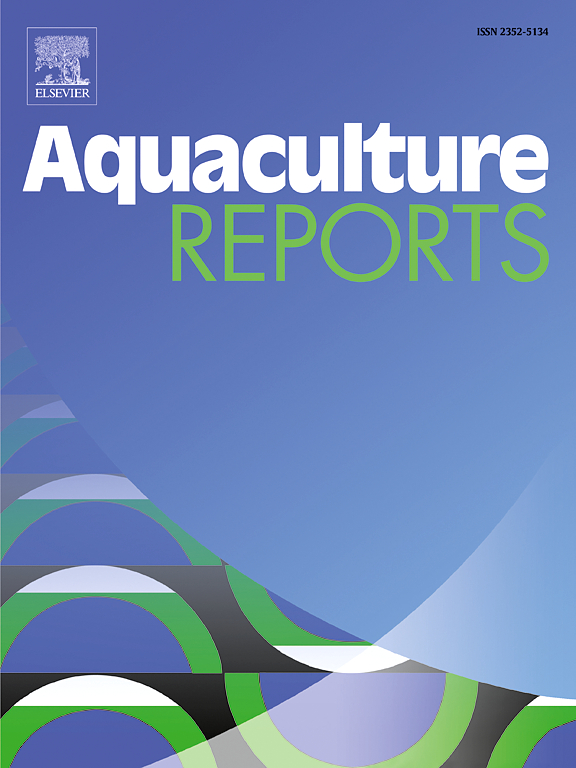Expression of sex-related genes and effects of dmrt1 siRNA-silencing on sex differentiation in juvenile yellow perch
IF 3.2
2区 农林科学
Q1 FISHERIES
引用次数: 0
Abstract
In this study, we first sequenced the entire genome of the yellow perch (YP) and screened transcripts of gonadal, liver and brain tissues from fish of different sexes. By comparing known sex-related genes in fish such as dmrt1 and cyp19a1 with YP genome, we obtained full-length sequences through genomic homology analysis. Then an experiment was conducted to determine the effects of dmrt1 siRNA-silencing on sex differentiation of juvenile YP. Transcriptome analysis showed that dmrt1 were mainly expressed in gonad tissue with their levels being significantly higher in the male groups respectively comparing to each other; foxl2 was dominantly expressed in gonads showing a significantly higher expression in big female groups than the male and small female groups. cyp19a1 was dominantly expressed in gonads, while cyp19a2 was dominantly expressed in brain, and both female groups exhibiting a significantly higher expression than the male groups. sox9a was mainly expressed in brain and gonad tissue with the male groups displaying a significantly higher expression in gonad than the female groups. For the dmrt1-siRNA interference experiment, a partial feminization of all-male fish was achieved despite administering the injection at a later stage of sex differentiation. The results showed that the dmrt1 gene interference led to an 20 % increase in the female number and larger size in both males and females compared to the control group. The percentage of females in the experimental group significantly increased to 70.09 %, compared to the 46.79 % in the negative control group. The interference also exerted a detrimental effect on the process of sperm production and maturation. The expression level of dmrt1 exhibited positive and negative correlations with body size of females and males, respectively. These findings suggest that dmrt1 plays a crucial role directly or indirectly in the sex differentiation and growth regulation of YP.
性别相关基因表达及dmrt1 sirna沉默对黄鲈幼鱼性别分化的影响
在这项研究中,我们首先对黄鲈(YP)的全基因组进行了测序,并筛选了不同性别鱼的性腺、肝脏和脑组织的转录本。我们将鱼类中已知的dmrt1、cyp19a1等性别相关基因与YP基因组进行比对,通过基因组同源性分析获得了全长序列。然后通过实验确定dmrt1 sirna沉默对YP幼鱼性别分化的影响。转录组分析显示,dmrt1主要在性腺组织中表达,且在雄性组中表达水平显著高于其他组;Foxl2在性腺中主要表达,雌性大组的表达量明显高于雄性和雌性小组。Cyp19a1主要表达于性腺,而cyp19a2主要表达于脑,且雌性组的表达量均显著高于雄性组。Sox9a主要表达于脑和性腺组织,雄性组在性腺的表达量显著高于雌性组。在dmrt1-siRNA干扰实验中,尽管在性别分化的后期进行了注射,但仍实现了全雄鱼的部分雌性化。结果显示,与对照组相比,dmrt1基因干扰导致雄性和雌性的雌性数量增加了20% %,体型更大。与阴性对照组的46.79 %相比,实验组的女性比例显著提高至70.09 %。这种干扰还对精子的产生和成熟过程产生不利影响。dmrt1的表达水平分别与雌性和雄性的体型呈正相关和负相关。这些发现表明dmrt1在YP的性别分化和生长调节中直接或间接地起着至关重要的作用。
本文章由计算机程序翻译,如有差异,请以英文原文为准。
求助全文
约1分钟内获得全文
求助全文
来源期刊

Aquaculture Reports
Agricultural and Biological Sciences-Animal Science and Zoology
CiteScore
5.90
自引率
8.10%
发文量
469
审稿时长
77 days
期刊介绍:
Aquaculture Reports will publish original research papers and reviews documenting outstanding science with a regional context and focus, answering the need for high quality information on novel species, systems and regions in emerging areas of aquaculture research and development, such as integrated multi-trophic aquaculture, urban aquaculture, ornamental, unfed aquaculture, offshore aquaculture and others. Papers having industry research as priority and encompassing product development research or current industry practice are encouraged.
 求助内容:
求助内容: 应助结果提醒方式:
应助结果提醒方式:


